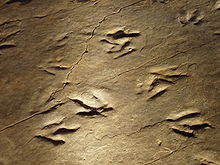| Eubrontes | |
|---|---|

| |
| Trace fossil classification | |
| Domain: | Eukaryota |
| Kingdom: | Animalia |
| Phylum: | Chordata |
| Clade: | Dinosauria |
| Clade: | Saurischia |
| Clade: | Theropoda |
| Ichnofamily: | †Eubrontidae |
| Ichnogenus: | †Eubrontes Hitchcock, 1845 |
| Type ichnospecies | |
| †Eubrontes giganteus (Hitchcock, 1836)
| |
| Ichnospecies | |
| |

Eubrontes is the name of fossilised dinosaur footprints dating from the Late Triassic and Early Jurassic. They have been identified from France, Poland, Slovakia,[2] Czech Republic,[3] Italy, Spain, Sweden, Australia (Queensland), US,[4] India,[5] China[1] and Brazil (South).[6]
Eubrontes is the name of the footprints, identified by their shape, and not of the genus or genera that made them, which is as yet unknown but is presumed to be similar to Coelophysis or Dilophosaurus. They are most famous for their discovery in the Connecticut River Valley of Massachusetts in the early 19th century. They, among other footprints, were the first known non-avian dinosaur tracks to be discovered in North America, though they were initially thought to have been made by large birds.
- ^ a b Li-Da Xing; Martin G. Lockley; Hendrik Klein; Li-Jun Zhang; Anthony Romilio; W. Scott Persons IV; Guang-Zhao Peng; Yong Ye; Miao-Yan Wang (5 July 2021). "The new ichnotaxon Eubrontes nobitai ichnosp. nov. and other saurischian tracks from the Lower Cretaceous of Sichuan Province and a review of Chinese Eubrontes-type tracks". Journal of Palaeogeography. 10 (1): 17. Bibcode:2021JPalG..10...17X. doi:10.1186/s42501-021-00096-y. S2CID 235730384.
- ^ Czech article about dinosaur trace fossil finds from Slovakia
- ^ Czech article about dinosaur trace fossils found in the Czech Republic
- ^ Lockley, M.; Matsukawa, M.; Jianjun, L. (2003). "Crouching Theropods in Taxonomic Jungles: Ichnological and Ichnotaxonomic Investigations of Footprints with Metatarsal and Ischial Impressions" (PDF). Ichnos. 10 (2–4): 169. doi:10.1080/10420940390256249. S2CID 128759174.
- ^ Iqbal, Mohammed (2021-09-03). "Rajasthan: Footprints of 3 dinosaur species found in Thar desert". The Hindu. ISSN 0971-751X. Retrieved 2021-09-13.
- ^ Silva, Rafael Costa da; Barboni, Ronaldo; Dutra, Tânia; Godoy, Michel Marques; Binotto, Raquel Barros (2012-11-01). "Footprints of large theropod dinosaurs and implications on the age of Triassic biotas from Southern Brazil". Journal of South American Earth Sciences. Tectonic and climatic shaping of the northern Andes and southern Caribbean margin. 39: 16–23. doi:10.1016/j.jsames.2012.06.017. ISSN 0895-9811.